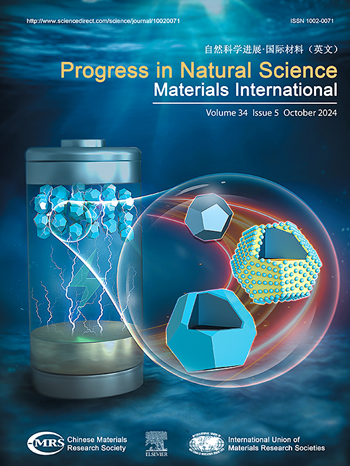光催化析氢用g-C3N4半导体催化剂的合成与改性研究进展
IF 7.1
2区 材料科学
Q2 MATERIALS SCIENCE, MULTIDISCIPLINARY
Progress in Natural Science: Materials International
Pub Date : 2025-06-01
DOI:10.1016/j.pnsc.2025.03.007
引用次数: 0
摘要
在阳光和半导体催化剂的参与下,光催化水分解制氢被认为是最有前途的绿色清洁能源供应策略。具有高活性和高稳定性的光催化剂对于高效产氢反应尤为重要和迫切。类石墨氮化碳(g-C3N4)作为一种二维半导体材料,由于其优异的稳定性、合适的带隙以及合适的能带结构,被广泛用于光催化水分解反应。本文从结构设计、元素掺杂、共催化剂改性、异相结构构建等调控策略等方面详细介绍了g-C3N4光催化剂的制备、改性策略及其在光催化水分解领域中的应用。同时,深入分析了采用不同策略修饰的g-C3N4半导体材料提高光催化制氢性能的机理。最后,展望了g-C3N4半导体催化剂在光催化制氢反应中的应用潜力和挑战。本文章由计算机程序翻译,如有差异,请以英文原文为准。

Synthesis and modification of g-C3N4 semiconductor catalysts for photocatalytic hydrogen evolution: A review
Photocatalytic water decomposition with the participation of sunlight and semiconductor catalysts to obtain the production of hydrogen is considered to be the most promising strategy to supply green and clean energy. The photocatalysts with high activity as well as high stability are particularly important and urgent for efficient hydrogen production reaction. As a two-dimensional semiconductor material, graphite-like carbon nitride (g-C3N4) is diffusely used for photocatalyzing water decomposition reactions because of its excellent stability, appropriate band gap as well as suitable energy band structure. Within this paper, the preparation as well as strategies for modifying g-C3N4 photocatalysts and the application in the field of photocatalytic water decomposition are introduced detailedly from regulatory strategies such as structural design, element doping, co-catalyst modification and heterogeneous structure construction. Simultaneously, the mechanism of the modified g-C3N4 semiconductor materials using different strategies in improving photocatalytic hydrogen production performance is deeply analyzed. Finally, the potential and challenges of g-C3N4 semiconductor catalysts in the application of photocatalytic hydrogen production reaction are prospected.
求助全文
通过发布文献求助,成功后即可免费获取论文全文。
去求助
来源期刊
CiteScore
8.60
自引率
2.10%
发文量
2812
审稿时长
49 days
期刊介绍:
Progress in Natural Science: Materials International provides scientists and engineers throughout the world with a central vehicle for the exchange and dissemination of basic theoretical studies and applied research of advanced materials. The emphasis is placed on original research, both analytical and experimental, which is of permanent interest to engineers and scientists, covering all aspects of new materials and technologies, such as, energy and environmental materials; advanced structural materials; advanced transportation materials, functional and electronic materials; nano-scale and amorphous materials; health and biological materials; materials modeling and simulation; materials characterization; and so on. The latest research achievements and innovative papers in basic theoretical studies and applied research of material science will be carefully selected and promptly reported. Thus, the aim of this Journal is to serve the global materials science and technology community with the latest research findings.
As a service to readers, an international bibliography of recent publications in advanced materials is published bimonthly.

 求助内容:
求助内容: 应助结果提醒方式:
应助结果提醒方式:


